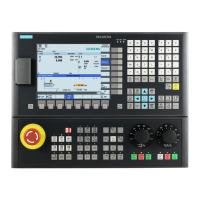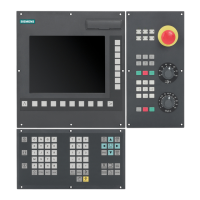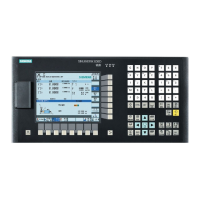K3: Compensations
4.4 Interpolatory compensation
Extended Functions
268 Function Manual, 03/2013, 6FC5397-1BP40-3BA1
Function
The parameterization of the sag compensation function is done by setting system variables
of the form: $AN_CEC ...
These system variables are normally set via a part program that processes the NCK in a
certain channel. The channel axis name can be used in the variables
$AN_CEC_OUTPUT_AXIS or $AN_CEC_INPUT_AXIS. This way, each axis of the channel
can be addressed, even if it is in a different NCU.
A program in Channel 2 can couple Axis ZZ with Axis XX via the following setting (the setting
is valid for the table with the number 0):
$AN_CEC_INPUT_AXIS[0] = (XX)
$AN_CEC_OUTPUT_AXIS[0] = (ZZ)
This way AX3 on NCU-1 is "coupled" with AX2 on NCU-2 (see configuration 1).
The following variants can be used to parameterize if the axes to be coupled are on two
different channels:
● Version 1: "Programming with channel axis name":
Two different part programs TP1 and TP2 are created, they are then processed in
different channels.
Axis "ZZ" is coupled to "XR":
View from the part program TP1 in Channel 1:
$AN_CEC_INPUT_AXIS[0] = (XR)
View from the part program TP2 in Channel 2:
$AN_CEC_OUTPUT_AXIS[0] = (ZZ)
Axis AX2 on NCU2 is coupled with Axis AX1 on NCU1 upon restart after TP1 is executed
in Channel 1 and TP2 is executed in Channel 2.
● Version 2: "Programming with machine axis name":
One part program is created that runs in any convenient channel of NCU1 and specifies
the machine axis names together with the NCU numbers.
Axis "ZZ" is coupled to "XR":
$AN_CEC_INPUT_NCU[0]=1
$AN_CEC_INPUT_AXIS[0] = (AX1)
$AN_CEC_OUTPUT_NCU[0]=2
$AN_CEC_OUTPUT_AXIS[0] = (AX2)
The NCK monitors whether the axes on the local NCU have actually been interpolated,
i.e. there is a channel that can program these axes. The local NCU is always the NCU on
which the part program runs.

